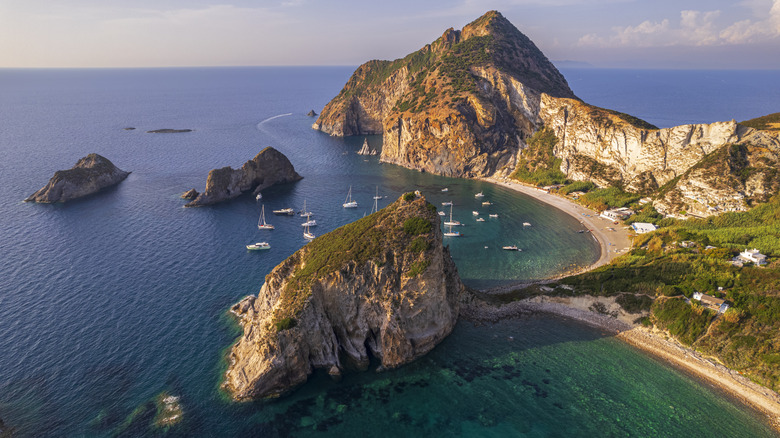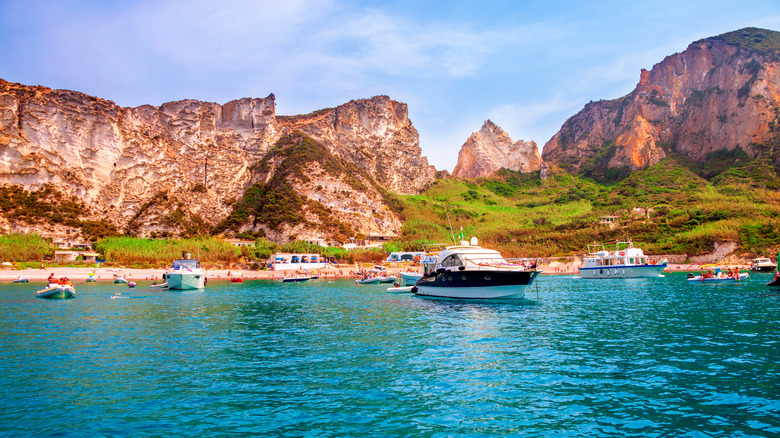Italy's Secret Island Full Of Natural Grottos, Cliffs, And Secluded Beaches Is A Mediterranean Haven
Surprisingly, around 6.5 million Italians live on islands. According to the European Commission, that's about 11% of the population, and while this may be a shocking statistic to some, perhaps it shouldn't be, given that the country is comprised of around 450 islands. Although there are plenty of beautiful Italian islands that don't get enough attention, many are popular with travelers, too. Tourists frequently outnumber residents on smaller islands, such as Capri, and even on larger islands like Sicily, which is home to about 4.8 million and saw 5.5 million visitors in 2023 (per Reuters).
However, a significant number of Italian islands are uninhabited, including Palmarola, a gorgeously rugged Mediterranean island that's part of the Pontine archipelago off of Italy's western coast. Volcanic activity helped shape the island's dramatic landscapes, from jagged cliffs and soaring rock faces to secret sea caves and grottos perfect for snorkeling. Without any year-round residents, the island stays blissfully tourist-free, save for the day-trippers who sail into Cala del Porto, Palmarola's only landing point, to enjoy the sun, sand, and sea.
Explore Palmarola's highlights
So what exactly should you see and do on Palmarola? First, it's important to understand that the island is not your typical Italian getaway with beachfront cafés and cobblestoned alleyways leading past historic churches. There are no roads on Palmarola — and no cars allowed, for that matter. There aren't any cultural monuments, shops, or luxury hotels. In fact, there's only one place you might be able to rent a room or have lunch: O'Francese, a seasonally operated, family-run restaurant and inn right on the beach across from Cala del Porto. There are a few hiking trails in the area, but to see most of the island's highlights, you'll want to join a boat tour.
Tours depart from the nearby island of Ponza, one of Italy's prettiest, lesser-known islands. Options vary, but on most boat excursions, you'll spend five to six hours cruising around Palmarola, enjoying lunch onboard. Depending on the type of experience you want to have, prices start at about $40 per person at the time of this writing. Along the way, you'll see the Cattedrale, a rock formation whose high basalt rocks resemble elegant cathedral columns, as well as natural archways and sea caves full of clear turquoise water. You'll also take breaks along the island's coastline to swim and snorkel before returning to Ponza in the afternoon.
Plan a trip to Ponza and Palmarola
In terms of weather, the best time to visit Palmarola is from May to September. There's one exception: Italians are typically on vacation in August, and the island gets busier during this time, which might slightly detract from the lost paradise atmosphere. Since most visitors see Palmarola on a boat trip from Ponza, the nearby island is a great place to base yourself. It's just as beautiful as Palmarola but much more developed. Two reasonably priced options near the harbor are the waterfront Hotel Gennarino a Mare and Hotel Bellavista, which can cost over $200 per night. There are plenty of pizzerias and restaurants in the same area, including La Baguetteria del Porto and Ristorante EEA.
Ponza, the gateway to Palmarola, is easily accessible from Rome or Naples (both of which have international airports). Rome is the best place to kick off an Italian vacation, and from Roma Termini train station, you can catch a train to the ports at Anzio or Formia, then take a ferry or hydrofoil to Ponza. Prices and lengths vary depending on the type of boat you choose, but plan to spend around $20 for a one-way journey that takes about 2.5 hours. From Naples, you could catch a direct three-hour ferry ride to Ponza, with one-way fares starting at $35. Note that many boats only operate in the summer season.


